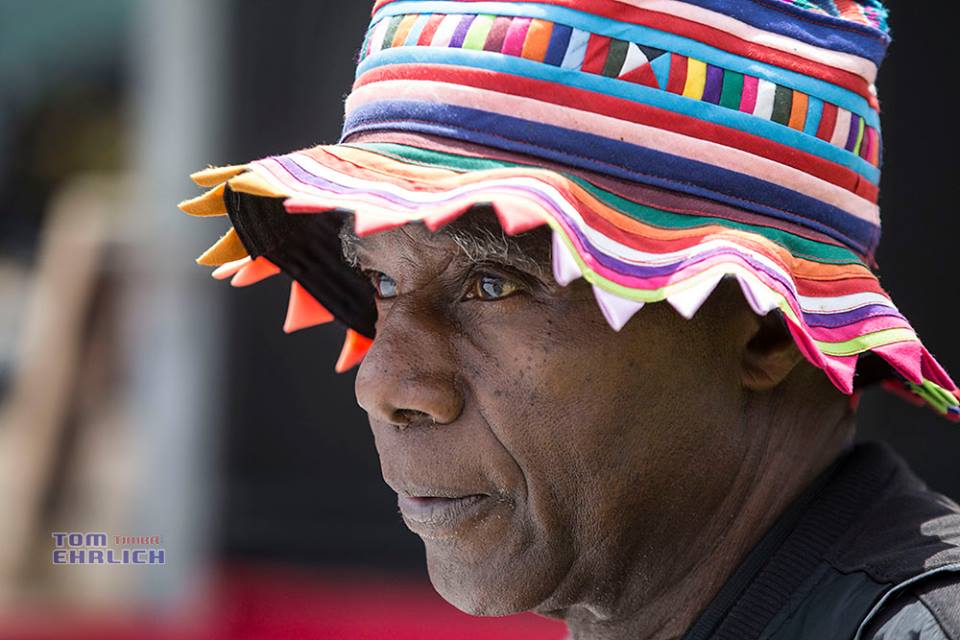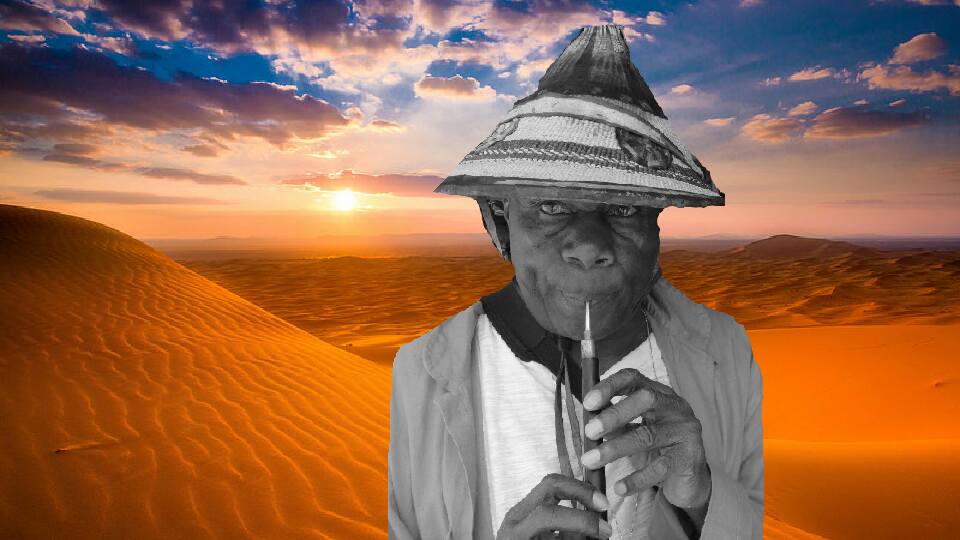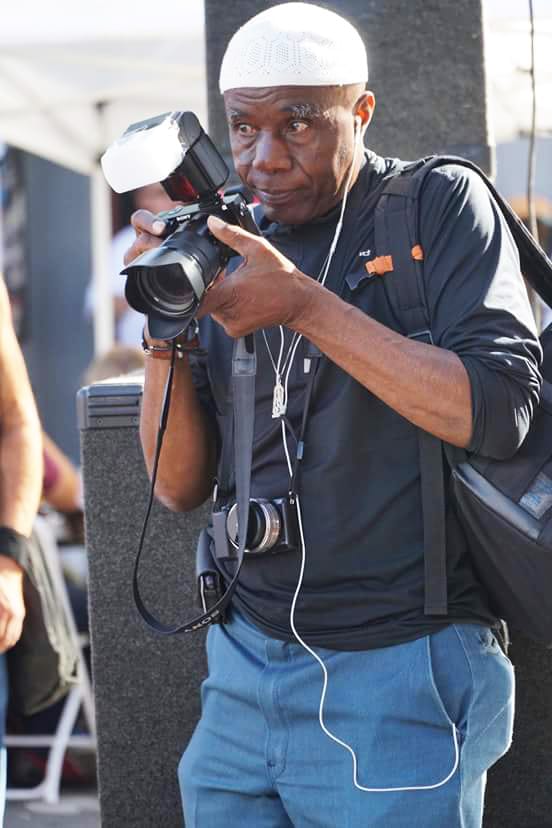Celebrate the life of Kamau Amen Ra on Friday, July 15, 5-9 p.m., at Eastside Arts Cultural Center, 2277 International Blvd., Oakland
by Wanda Sabir

I was in Ghana when I received news that Kamau Amen Ra made his transition, and it was at an exhibit at the British Museum in London walking through the chambers of Ausar that I reflected on his well-lived life. As I looked at the treasures discovered recently in Thonis-Heracleion and Canopus, cities which lay at the mouth of the Nile, part of the “lost cities” exhibition, I thought about the human treasures undiscovered who walk among us, like Kamau Amen Ra. I think Kamau called this place Babylon, a place where treasures remain unearthed or hidden except for those with keen eyes or vision, both of which Kamau possessed.
These cities, prior to their excavation over the past 20 years, led by world-renowned archaeologist Franck Goddio and his team, lay at the mouth of the Nile, and, according to museum literature, are named after “the Greek hero Heracles. Thonis-Heracleion was one of Egypt’s most important commercial centers for trade with the Mediterranean world, and Canopus was a major center for the worship of the Egyptian gods. Their amazing discovery is transforming our understanding of the deep connections between the great ancient civilizations of Egypt and Greece.”
“These buried discoveries are seen alongside fascinating objects from major Egyptian museums for the first time in the UK.” Certainly, one’s next stop is the Nile Valley in Egypt: Luxor, Aswan, Cairo and Alexandria.
Sacred and commercial centers, these reimagined cities, Thonis-Heracleion and Canopus, are evidence of the greatness that was Kemet despite eventual occupation. The cities thrived as Greeks were welcomed[1] and eventually took over leadership as gods beginning with the reign of Alexander III, then his Gen. Ptolemy. We see evidence of the shameless commodification of the sacred: from the Greek name of one of the cities to the export of goods during what is called “the cult of Osirus.”
The interplay between African gods and rituals and those of the Greeks, for purposes of eventual domination, is cleverly crafted as Greek deities are erected next to Kemetic ones with hyphenated names like “Ausar Sokaris.” For Ptolemy to be accepted as pharaoh, following the death of Alexander the Greek, he has evoked the look of the natives with ceremonial items. His sister-wife is depicted with locs.
Later Dionysus is exchanged for Ausar, the sacred family – Ausar, Auset and Heru – part of the lineage Helena rulers claimed. No longer Kemet or the land of the Blacks, these impostors donned African spirituality like Zionists don Judaism. The last native pharaoh was Nectanebo II (360-342). His head was found discarded near others at the Canopus temple. The introduction of Christianity leads to the dumping of statues like his and Serapis (the whitened Ausar).

The earth god, Geb, and sky goddess, Nut, give birth to Ausar, Auset and Set. Ausar is reincarnated and is said to be the patron of the underworld, and Auset is the mother goddess (Yemanja) and patron of magic. Their child is Heru. Together with their son, they form the sacred family – Mary, Joseph and Jesus.
Primary research is where the truth lies. The artifacts carry their own tales of capture. Audio tours and catalogs cannot erase the desecration of sacred objects and the submersion of Canopus, where Ausar was celebrated and honored between mid-October and mid-November. Large vessels or tubs were used to grow vegetation which would simulate the god’s rebirth. Auset appears on his tomb as a bird fanning him.
After the Immaculate Conception (Auset uses magic to awaken her deceased spouse, King Ausar, where she conceives their son, Heru), Heru is hidden in the wilderness from Set, his uncle, Bess[2] protects him. There is a lovely stele (a wooden slab erected as a monument) with Heru as a mature youth ready to face fate. There are enormous edifices throughout the exhibition that speak to the majesty of the period, despite their philosophical dilution or assimilation with the Greeks.
As I walked through the exhibition and looked at the names of Amun, king of ancient Egyptian gods, juxtaposed with the Greek god Zeus, I thought about Kamau Amen Ra, the Black god, and the subtleties of Blackness – as in melanin – and Black power.
As I walked through the exhibition and looked at the names of Amun, king of ancient Egyptian gods, juxtaposed with the Greek god Zeus, I thought about Kamau Amen Ra, the Black god, and the subtleties of Blackness – as in melanin – and Black power.
Kamau witnessed with his camera. Like the creator god Amen, he loved shaping and sculpting light (Ra), color and form. Amen-Ra, the photographer, references the hidden aspect of the art form. Unlike other visual mediums, the photographer is often surprised by what he captures – no matter how skillful the eye and precise the instrument, there is magic in medium.
On any given day, he’d share his new cameras and what features were unique to each. I never saw Kamau without a camera except when he was at work with the developmental community he supervised on a job site or when he’d play his reed at the Berkeley Flea Market. I remember one time he showed me cards he’d made of photos taken with his Sony. He then walked me around the Flea Market framing each shot in my hand. He showed me how he used Illustrator and color accents to make the images unique. Just before I went to Ghana in May, Kamau sent me a link to a new camera when I told him how much repairing the flash on my old camera would cost.

Midwest native, Kamau was my introduction to Black Chicago. Lorraine Hansberry my literary introduction, Kamau a history I could touch. He told me about going to DuSable, a Black high school located in the Bronzeville neighborhood, playing music with his AACM (Association for the Advancement of Creative Musicians) and Art Ensemble mentors. I always wished I’d interviewed Kamau. His passing is like several libraries burned down.
I always wished I’d interviewed Kamau. His passing is like several libraries burned down.
Kamau was underappreciated, yet he didn’t let it keep him from doing his work. His more recent work as a curator at the San Leandro and Berkeley Public Libraries were opportunities for the Bay Area communities to see the breath that is Black photography, with an emphasis on jazz or creative arts. The receptions were showcases that pulled together the best of the Black aesthetic – visual, musical and movement.
The book on Black artists in the Bay Area owes much to Kamau’s archives. I recall discussions with him when that book came out about doing his own book. I was interested in helping. Kamau Amen Ra and Kimara Dixon and I used to be a team. They would take the photographics and I’d write the stories. Kamau then started writing and his photos made the back pages of the San Francisco Bay View the talk of the town.
I think his foray into curating was a way to keep his work out there. Certainly we need to have a Kamau Amen Ra Photography Exhibit and Award to be curated by a jury of his peers. I’d like to volunteer as coordinator for 2017 and would appreciate hearing from other interested parties, especially friends and artists who knew him well.
I would also like to have a book next year filled with Kamau Amen Ra moments: personal testimonies, stories our brother shared.
Kamau, like many elders, was under-employed and had to work when he should have been retired. His pension was not enough to support him, and Kamau was not extravagant.
His the story of another elder, Brother Tahuti, whom we lost last year.
I hope she doesn’t get angry with me, but Sister Makinya, who is 89 July 1, is another elder who lives alone.
A friend’s sister in Birmingham, just outside London, says that her husband, a social worker with child and adult protective services has to rescue elders who are alone and lonely. From Zimbabwe in Africa, if the family is not around, neighbors will take care of elders. Kamau was found by a neighbor. Brother Tahuti was found by a neighbor too.
We need to look at better ways to care for our elders, even if they resist (smile). We can call daily and drop by with meals, offer transportation, give these elders money, ask about their health, pay for treatment – be the kind of family and community we’d like for our dear ones.
Let’s let Kamau’s passing be the last elder passing whom we did not know was ill or needed our support.
Kamau was our Gordon Parks with the Honorable Marcus Mosiah Garvey pulsing through his veins. What a powerful combination. Ashay!
Kamau was our Gordon Parks with the Honorable Marcus Mosiah Garvey pulsing through his veins. What a powerful combination. Ashay!
Celebrate Kamau
There is a Celebration of the Life of Kamau Amen Ra, Friday, July 15, 2016, 5-9 p.m., at Eastside Arts Cultural Center, 2277 International Blvd., Oakland. Visit: www.eastsideartsalliance.org.
All who loved Kamau are welcome to come. There is an exhibition of some of his work. Guests are asked to bring a dish to share. If anyone is a musician and would like to participate, please contact Muziki Roberson at muzirobe@sbcglobal.net.
Bay View Arts Editor Wanda Sabir can be reached at wanda@wandaspicks.com. Visit her website at www.wandaspicks.com throughout the month for updates to Wanda’s Picks, her blog, photos and Wanda’s Picks Radio. Her shows are streamed live Wednesdays at 7 a.m. and Fridays at 8 a.m., can be heard by phone at 347-237-4610 and are archived at http://www.blogtalkradio.com/wandas-picks.
[1] According to British literature, Egyptian leadership did not impose their spirituality on visitors; rather, they built temples where these outsiders could worship freely.
[2] I couldn’t help but compare “Porgy and Bess” with this older tale where “Bess” protects Heru. Bess is a scary looking god, similar to the way crippled Porgy is depicted in the story. “Porgy,” a novel written by Charleston, S.C., native DuBose Heyward (1926), is read by George Gershwin, who shows interest, but is too busy at that time. So what happens is DuBose, with his wife Dorothy’s assistance, adapts the work for stage, and it runs for 367 shows. The Theatre Guild run is quite successful and attracts other interested parties like Al Jolson; however, the musical adaptation is still to come, when the George and Ira Gershwin connection (1934) seals its famed theatrical fate.





